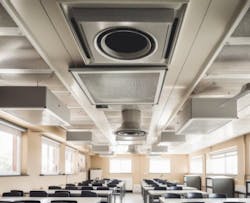Knowledge Center: HVAC and IAQ
Maintaining good indoor air quality (IAQ) in schools is vital for the health and safety of students and staff and has always been a priority for educational facility managers. But since the Covid-19 pandemic, the connection between inadequate indoor air quality and possible transmission of airborne diseases has raised the stakes for schools and universities.
Since the Covid-19 disease spread across the nation in 2020 and shut down virtually all education facilities, school administrators have put greater focus on the HVAC systems in their buildings—how well they are functioning and whether they need upgrading or replacement to provide students and staff with healthy indoor environments.
The U.S. Environmental Protection Agency has assembled plenty of guidance that can help education institutions select, operate and maintain their HVAC equipment so that a facility has good indoor air quality.
“The selection of equipment for heating, cooling and ventilating the school building is a complex design decision that must balance a great many factors,” the EPA says.
Among those factors: heating and cooling needs; energy efficiency; humidity control; potential for natural ventilation; adherence to codes and standards; outdoor air quantity and quality; IAQ; and cost.
“Where feasible, schools should use central HVAC air handling units that serve multiple rooms rather than unit ventilators or individual heat pumps,” the EPA says.
The agency says central air handling units have several advantages compared with unit ventilators and heat pumps serving individual rooms. They are quieter and therefore more likely to be turned on or left on by teachers and staff; they’re better at controlling humidity and condensed moisture drainage; they’re easier to maintain because they have fewer components; there is more space around units and workers can access them without interfering with class activities; and they have space for higher efficiency air filters and more surface area.
Ventilation strategies
Making sure school facilities have adequate ventilation and filtration is critical
“To reduce pollutants in the air and limit the spread of viruses and bacteria, schools should maximize ventilation rates to the extent possible by bringing in as much outdoor air as weather and outdoor air quality permit,” the EPA says. “To reduce pollutants in the air and limit the spread of viruses and bacteria, schools should maximize ventilation rates to the extent possible by bringing in as much outdoor air as weather and outdoor air quality permit.”
Steps to take to increase a system’s ventilation rate:
- Conduct an HVAC assessment to evaluate the condition of the existing HVAC system components and unit ventilation equipment.
- Have a scheduled inspection and maintenance program for HVAC systems in place to allow for repairs, modifications or replacement of equipment.
- Assess and service ventilation systems to ensure they perform as designed.
- Adjust the HVAC system to bring in more outdoor air.
- When HVAC adjustments are not possible, consider other ways to bring in outdoor air, such as opening windows and using window fans, if weather and outdoor air quality permit.
- Keep unit ventilators clear of books, papers and other items that could reduce airflow.
When schools are not able to make sufficient HVAC adjustments, they should consider increasing HVAC filter efficiency and using portable air cleaners as a supplemental filtration strategy, the EPA says.
Facility managers can increase filter efficiency in existing HVAC systems by using filters with the highest Minimum Efficiency Reporting Value (MERV) rating possible (per equipment specifications). “If possible, increase the level of the air filter to MERV 13 or higher,” the EPA says.
If schools choose portable air cleaners as a supplemental filtration strategy, they should select portable air cleaners that use proven technology and are appropriately sized for the spaces they will service.
“Do not use air cleaners that intentionally generate ozone in occupied spaces or that do not meet state regulations or industry standards for ozone generation,” the EPA says. “If air cleaners are used, they should be placed so that air is not blown directly from one person to another, as this could potentially facilitate the spread of viruses and bacteria to others. Air flow to and from air cleaners should not be obstructed.”
Other recommendations from the EPA: Schools should pay special attention to preventing moisture from entering duct work; wet duct surfaces can lead to mold growth. Schools also should make sure the air ducts in their HVAC systems are sealed to prevent air leakage.
“In addition to significant energy losses, air leakage from HVAC ducts and air handling units cause significant IAQ problems due to unexpected airflow between indoors and outdoors and between areas within the school,” the EPA says.
